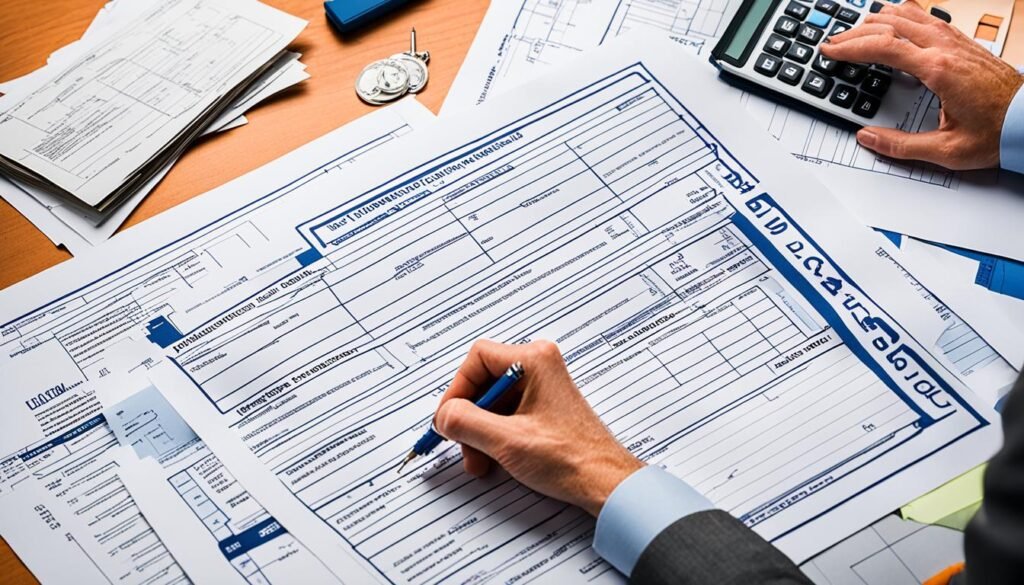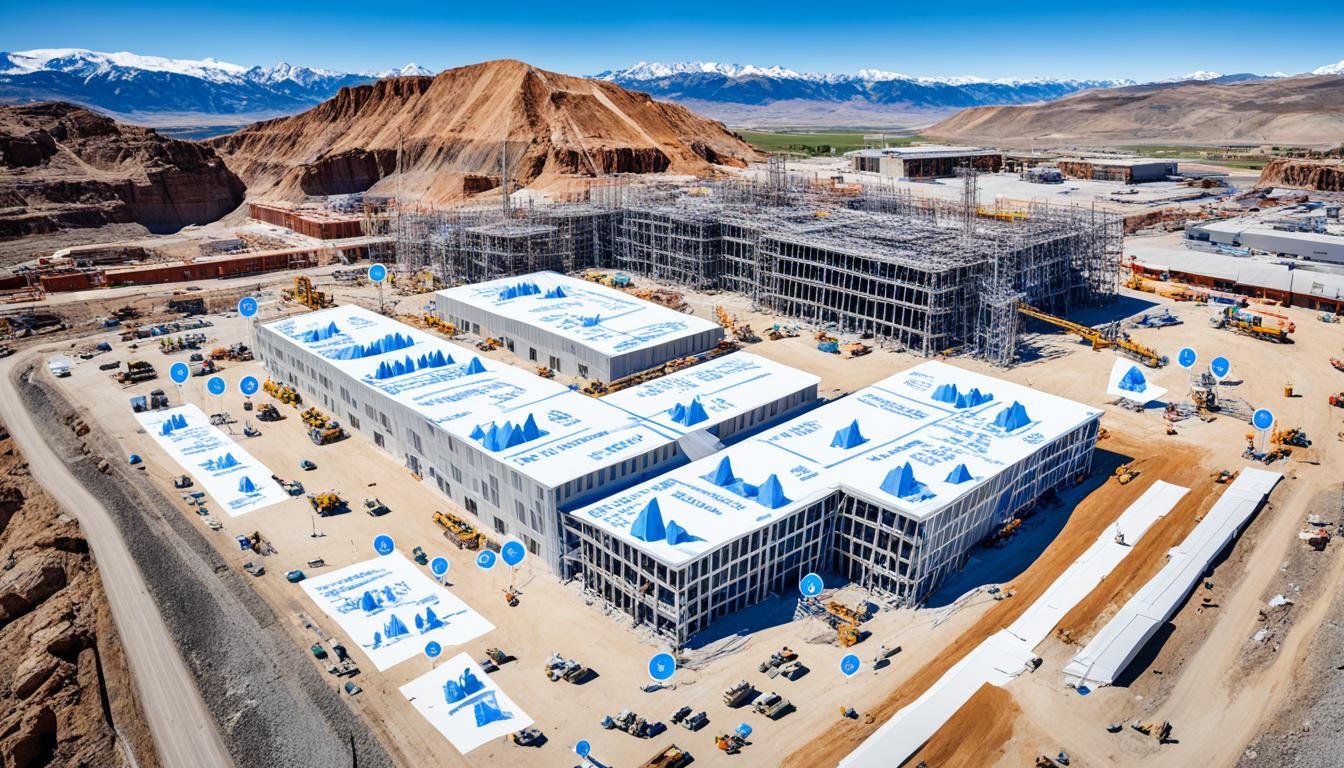Starting a new construction project is exciting. But, navigating the building permit process can feel overwhelming. Many people find this task daunting. They struggle with figuring out how to get building permits in Utah.
If you’re planning to renovate, add an extension, or build something new, you need to understand permits. Don’t worry, though. This guide simplifies the Utah building permit process for you. We’ll explain everything from application to approval.
Key Takeaways:
- It’s crucial to know the Utah building permit process for construction projects.
- Most construction tasks need permits, except minor cosmetic changes.
- Not getting a permit can cause fines and slow down property sales.
- Permit fees depend on the project’s value.
- Homeowners can get permits for their main home. Yet, professionals must handle rental or business properties.
Why Do I Need a Permit?
Building permits are key for our safety and health. They set rules to protect us from dangers in constructions. Getting a permit is a must for any construction work. This includes new buildings, changes, fixes, or taking down a structure. They’re also needed for electrical, plumbing, and mechanical work.
Getting the right permits means you’re looking out for your project and everyone involved. Utah’s building codes focus on keeping people safe. Not having a permit can lead to fines. More critically, it could risk the safety of the building.
“Building permits are like the superheroes of the construction world. They swoop in to save the day and protect us all from potential dangers. Without them, it’s like letting the villains run wild!”
You need a permit for the safety and well-being of everyone in a building project. It’s crucial we all follow Utah’s rules for permits and building codes.
When Do I Need a Permit?
Most construction work means getting a permit. We’re here to help with the utah building permit process. Still, some projects are exceptions. You can paint or lay flooring without one. So, unleash your creativity without worrying about paperwork.
For certain situations, talk to the Permits Office. They can offer advice unique to your situation. This helps you know if you need a permit. We also have a list of typical exemptions for you:
- Playhouses under 200 square feet
- Retaining walls under four feet in height
- Window awnings that project less than 54 inches
Remember, small repair jobs under $1000 don’t need a contractor. If you’re good with tools and ready for small fixes, start your project. Just focus on safety and follow building permits in Utah rules.
Don’t Forget!
“Permits are like a safety net, ensuring that your construction project is up to code and safe for all involved.”
How are Permit Fees Decided?
Getting a building permit in Utah means you need to know the cost. Permit fees are set based on your project’s overall value. This includes both the materials and labor costs or the bid from your contractor. It’s vital to accurately estimate your project’s value to figure out the fees.
Salt Lake City has fee and valuation tables on its website to help you. These tools are very useful for figuring out your construction costs. Make sure to use these resources to know what your building permit will cost.
Utah allows you to pay permit fees in several ways, including cash, credit cards, checks, and eChecks. This variety means you can pay in the way that works best for you. It makes the payment process easy and flexible.
Knowing how permit fees are figured out is key when getting a Utah building permit. Being aware of the costs ahead of time helps you plan your budget. This way, you can steer clear of any unexpected expenses.
Example Permit Fees
| Project Type | Permit Fee |
|---|---|
| New Residential Construction | $0.19 per square foot |
| Residential Remodeling | $0.12 per square foot |
| Commercial Building | $0.25 per square foot |
| Electrical Installation | $60 for first 10 outlets, $5 per additional outlet |
| Plumbing Installation | $100 for first fixture, $20 per additional fixture |
The table above shows example permit fees for various projects in Utah. Remember, these fees are just examples and may not match your exact project fees. Always check the official fee tables for precise calculations.
Can I Obtain the Permit Myself?
If you own property, you may wonder if you can get building permits in Utah for your home. The answer is “Yes,” but there are important things to consider.
For homes, you can handle the permit process yourself. Just remember, you must also submit an Owner/Builder Certification with your plans. This shows you’re in charge of the build and will follow all building rules.
But for rental or commercial properties, you need a licensed contractor for permits. This ensures the project meets safety and building standards, thanks to their expertise.
If you’re looking at small fixes or upgrades under $1000, like a leaky faucet or wall painting, you don’t need a contractor. You can do these tasks on your own without a permit.

Save Money and Take Control
“By allowing property owners to obtain permits for their primary residences, Utah empowers homeowners to take control of their construction projects. This approach not only saves money by eliminating the need for contractor fees but also provides an opportunity for personal growth and a sense of accomplishment.”
If you believe in your building skills and are ready for the task, getting a permit for your home can be rewarding and save you money.
Who is Responsible for Getting the Permit?
In Utah, figuring out who gets the building permit is key. Usually, if you’re working with a contractor, they’ll handle the permit process for you. They make sure everything follows the building codes.
But what if you decide to hire a contractor and take out the permits yourself?
Well, that’s when things get a little more interesting.
Taking the permits on yourself means you’re also on the hook for the work. You have to ensure all is done right and follows the rules.
So, why would you want to take on this additional responsibility?
Maybe you know the permit process well, or you want more control. The key is to work closely with the permit office. You need to know all about the permits and rules.
Remember:
Obtaining the permits yourself comes with added responsibility.
Stay informed and involved in the permit process. This way, you can keep everything on track and avoid problems.
So, choose wisely between working with a contractor or taking on the permits yourself. Knowing the Utah building permit process well ensures a smooth project.

Benefits of Hiring a Contractor for Permit Compliance:
- Expertise: Contractors know the building permit process inside out.
- Saves Time: They handle permits, so you can focus on the project.
- Reduces Liability: A licensed contractor means quality work that meets codes.
Who is Responsible for the Inspections?
In the Utah building permit process, knowing who’s in charge of inspections is key. It falls on the property owner or the contractor to make sure they get done. This step is crucial for sticking to building codes and regulations.
Inspectors have a big job in making sure construction is safe and up to par. They check the work at several points, like for the frame, electrical setup, and plumbing. These checks are to make sure everything is safe and well done.
It’s important to get inspections at the right time. This helps fix any problems early, avoiding delays or big issues later. Before moving to the next construction phase, an inspection has to be passed.
Don’t overlook inspections. They’re a big part of building safely. Missing out on them can lead to serious trouble. As owners or contractors, it’s our job to line up these inspections right.
Getting help from the permit office is a must. They can guide you on when and how to plan inspections. They’ll also clear up any confusion about the rules you need to follow.
By making sure inspections are done, we show we’re serious about safety and following the rules. Doing this helps our construction projects succeed in the end.
Conclusion
We hope this guide helps you understand the Utah building permit process. Getting the right permits ensures your construction is safe and legal in Utah. Always follow the building codes and get advice from the permit office when needed.
Start by doing your homework on the permit process. Make sure you know the rules and have all your papers ready. This will make the process smoother and avoid construction delays.
With this information, you’re ready to start your construction project in Utah. We wish you success and hope your project goes well. Remember to always follow the regulations and requirements.
FAQ
What is the Utah building permit process?
Why do I need a permit?
When do I need a permit?
How are permit fees decided?
Can I obtain the permit myself?
Who is responsible for getting the permit?
Who is responsible for the inspections?
Source Links
- https://www.saratogasprings-ut.gov/220/Obtaining-a-Building-Permit
- https://www.westjordan.utah.gov/community-development/building-and-safety/
- https://www.slc.gov/buildingservices/building-permits/faqs/


